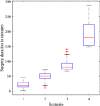Machine learning based integrated scheduling and rescheduling for elective and emergency patients in the operating theatre
- PMID: 36694896
- PMCID: PMC9851122
- DOI: 10.1007/s10479-023-05168-x
Machine learning based integrated scheduling and rescheduling for elective and emergency patients in the operating theatre
Abstract
As the only largest source of revenue and cost in a hospital, the operation room (OR) scheduling problem is a hot research topic. Nonetheless, an integrated model is the missing key to managing and improving the efficiency of ORs. This paper presents a fully integrated model regarding three concepts: meditating elective patients and emergency patients together, considering ORs and downstream units, and proposing hierarchical weekly, daily, and rescheduling models. Due to the inherent randomness in emergency patient arrival, a random forest machine learning model and geographical information systems are used to obtain the emergency patient surgery duration and arrival time, respectively. According to the machine learning model in weekly and daily scheduling, initially, fixed capacity is reserved for emergency patients. When an emergency patient arrives, the surgery starts if a reserved OR is available. Otherwise, the first available OR will be dedicated to the patient due to an emergency patient's higher priority than an elective patient. In this case, it is needed to reschedule the OT schedule for the remaining patient. Moreover, the three-phase model guarantees that an emergency patient assigns to an OR within a specific time limit. To solve the models, genetic algorithm and particle swarm optimization are developed and compared. In addition, a real-world case study is undertaken at a hospital. The results of comparing the proposed approach to the hospital's current scheduling show that the three-phase model had a considerable positive effect on the ORs schedule.
Keywords: Elective and emergency patients; Machine learning; Operating room planning; Operating theater scheduling; Rescheduling.
© The Author(s), under exclusive licence to Springer Science+Business Media, LLC, part of Springer Nature 2023, Springer Nature or its licensor (e.g. a society or other partner) holds exclusive rights to this article under a publishing agreement with the author(s) or other rightsholder(s); author self-archiving of the accepted manuscript version of this article is solely governed by the terms of such publishing agreement and applicable law.
Conflict of interest statement
Conflict of interestThe authors declare that they have no conflict of interest.
Figures











Similar articles
-
Developing an efficient scheduling template of a chemotherapy treatment unit: A case study.Australas Med J. 2011;4(10):575-88. doi: 10.4066/AMJ.2011.837. Epub 2011 Oct 31. Australas Med J. 2011. PMID: 23386870 Free PMC article.
-
A short-term operating room surgery scheduling problem integrating multiple nurses roster constraints.Artif Intell Med. 2015 Feb;63(2):91-106. doi: 10.1016/j.artmed.2014.12.005. Epub 2014 Dec 12. Artif Intell Med. 2015. PMID: 25563674
-
Simulation-based evaluation of operating room management policies.BMC Health Serv Res. 2021 Mar 24;21(1):271. doi: 10.1186/s12913-021-06234-5. BMC Health Serv Res. 2021. PMID: 33761931 Free PMC article.
-
Artificial Intelligence: A New Tool in Operating Room Management. Role of Machine Learning Models in Operating Room Optimization.J Med Syst. 2019 Dec 10;44(1):20. doi: 10.1007/s10916-019-1512-1. J Med Syst. 2019. PMID: 31823034
-
Healthcare scheduling in optimization context: a review.Health Technol (Berl). 2021;11(3):445-469. doi: 10.1007/s12553-021-00547-5. Epub 2021 Apr 10. Health Technol (Berl). 2021. PMID: 33868893 Free PMC article. Review.
Cited by
-
Natural Language Processing (NLP)- and Machine Learning (ML)-Enabled Operating Room Optimization: A Preferred Reporting Items for Systematic Reviews and Meta-Analyses (PRISMA) Systematic Review Anchored in Project Planning Theory.Cureus. 2025 Apr 22;17(4):e82796. doi: 10.7759/cureus.82796. eCollection 2025 Apr. Cureus. 2025. PMID: 40416208 Free PMC article. Review.
-
WindowSHAP: An efficient framework for explaining time-series classifiers based on Shapley values.J Biomed Inform. 2023 Aug;144:104438. doi: 10.1016/j.jbi.2023.104438. Epub 2023 Jul 4. J Biomed Inform. 2023. PMID: 37414368 Free PMC article.
-
Artificial Intelligence in Operating Room Management.J Med Syst. 2024 Feb 14;48(1):19. doi: 10.1007/s10916-024-02038-2. J Med Syst. 2024. PMID: 38353755 Free PMC article.
-
The Role of Machine Learning in Management of Operating Room: A Systematic Review.Cureus. 2025 Feb 21;17(2):e79400. doi: 10.7759/cureus.79400. eCollection 2025 Feb. Cureus. 2025. PMID: 40125180 Free PMC article. Review.
-
Factors affecting operating room scheduling accuracy for primary and revision total hip arthroplasty: a retrospective study.Arch Orthop Trauma Surg. 2024 May;144(5):2403-2411. doi: 10.1007/s00402-024-05296-4. Epub 2024 Apr 5. Arch Orthop Trauma Surg. 2024. PMID: 38578311
References
-
- Addis, B., Carello, G. & Tànfani, E. A robust optimization approach for the operating room planning problem with uncertain surgery duration. In Proceedings of the international conference on health care systems engineering, 2014. (pp. 175–189) Springer.
-
- Addis B, Carello G, Grosso A, Tànfani E. Operating room scheduling and rescheduling: A rolling horizon approach. Flexible Services and Manufacturing Journal. 2016;28:206–232. doi: 10.1007/s10696-015-9213-7. - DOI
-
- Akbarzadeh B, Moslehi G, Reisi-Nafchi M, Maenhout B. The re-planning and scheduling of surgical cases in the operating room department after block release time with resource rescheduling. European Journal of Operational Research. 2019;278:596–614. doi: 10.1016/j.ejor.2019.04.037. - DOI
LinkOut - more resources
Full Text Sources
Research Materials
